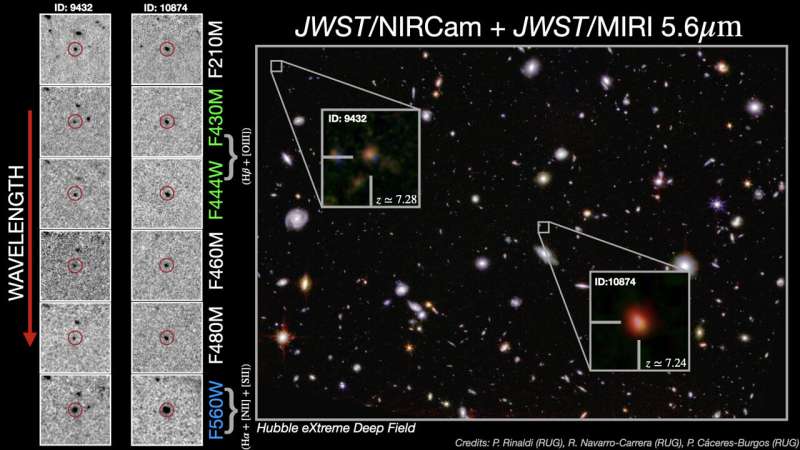This article has been reviewed according to Science X's editorial process and policies. Editors have highlighted the following attributes while ensuring the content's credibility:
fact-checked
peer-reviewed publication
trusted source
proofread
MIRI instrument on JWST detects H-alpha emission during the Epoch of Reionization for the first time

An international team of astronomers led by Pierluigi Rinaldi of the University of Groningen has detected for the first time H-alpha emission in individual galaxies during the so-called Epoch of Reionization, or cosmic dawn. To do so, they used the deepest images taken so far by the MIRI instrument on the James Webb Space Telescope. The result has been accepted for publication in The Astrophysical Journal, and is currently published on the arXiv preprint server.
Star-forming galaxies produce a large amount of UV photons, but during the Epoch of Reionization these photons are absorbed by the intergalactic medium. The best tracer to measure the level of star formation is the H-alpha emission line in the optical spectrum. For galaxies with high redshift, this optical line is shifted to longer wavelengths, to the near- and mid-infrared.
The H-alpha line has now been studied—with the MIRI instrument on JWST—for the first time for galaxies with a redshift higher than seven (z>7) during the cosmic dawn, the period less than a billion years after the Big Bang, during which neutral hydrogen gas ionized. The research by Rinaldi and colleagues shows for the first time that a detailed study of star formation in early galaxies is possible and can be carried out with JWST/MIRI.
Little is known about galaxies in the Epoch of Reionization. At high redshifts, previous studies have relied on the analysis of another prominent spectral line called Lyman-alpha, but this line becomes very faint or is generally not present at all in galaxies in the cosmic dawn because it is absorbed by the intergalactic medium, which is mostly opaque in that early period. H-alpha is not affected by the opacity of the intergalactic medium and thus allows astronomers to study star formation in these early galaxies.
MIRI is an important tool for this research, as is one of the other four instruments on Webb, NIRCam. The ultra-deep MIRI image used in this study was obtained within the so-called MIRI European Guaranteed Time. The researchers also used ancillary data from HST in the Hubble eXtreme Deep Field (XDF).
The researchers first searched for star-forming galaxies that might have emission lines at the time of reionization, based on their analysis of the more sensitive NIRCam images. Then they analyzed images of these preselected galaxies at longer wavelengths with MIRI. They found that many of them are very bright at 5.6 microns, indicating that a very prominent H-alpha emission line is present in these sources.
First author Pierluigi Rinaldi says, "This research opens up the possibility of studying early galaxies in a way not possible before. The great thing is that we have shown that this kind of study can be done routinely with JWST/MIRI."
The astronomers plan to follow up galaxies spectroscopically with JWST. The aim is to learn more about the shape of the galaxies' emission lines, which could tell them more about the gas kinematics and the dynamics of star formation.
More information: P. Rinaldi et al, MIDIS: Strong (Hb + [OIII]) and Ha emitters at redshift z≃7−8 unveiled with JWST/NIRCam and MIRI imaging in the Hubble eXtreme Deep Field (XDF), arXiv (2023). DOI: 10.48550/arxiv.2301.10717
Journal information: Astrophysical Journal , arXiv
Provided by Netherlands Research School for Astronomy





















